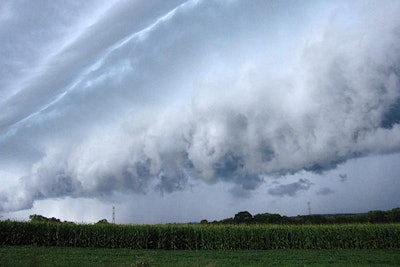
“It is an observable, comprehensive shift,” said Kenny Blumenfeld, senior climatologist at the Minnesota State Climatology Office during a presentation at the 2018 Midwest Organic and Sustainable Education Service (MOSES) Organic Farming Conference on February 23 in La Crosse, Wisconsin. “Any way you cut this, it matters.”
Blumenfeld outlined climate changes currently impacting agriculture and what Midwestern farmers in the Corn Belt should expect during upcoming growing seasons. First, however, he wanted to make one thing clear: “Observations and projections are two different fields of climate science.” It is past observed data versus modeled or simulated future data. When we talk about the past, explained Blumenfeld, we are talking about things that we have measured: temperature, wind, moisture, humidity, rainfall, pressure, solar radiation. When we talk about the future, we are talking about simulating a range of scenarios that could happen based on our understanding of how this atmosphere behaves. The two different fields are often confused, and it’s important to understand them and their differences.
It is also important to understand variability. “We can have a trend, and we can also have variability along that trend. And having one does not disprove the other or prove the other,” said Blumenfeld. For example, he explained, in the winter of 2014, many places in the upper Midwest had the most severe winter seen in 80 years. “A lot of people thought, ‘Where’s global warming now?’” said Blumenfeld, who then stressed, “We have variability. We’re allowed to get cold even while we warm.”
Coping with a changing climate: What will the future bring?
Weather and climate patterns are a driving force behind the success or failure of Corn Belt cropping systems. The upper Midwest region has seen a 15 percent increase in water occurring in bigger events, with most of the rest of the region receiving 10 percent more rainfall, according to USDA data. North Central Ohio received 15 inches of rain in September 2016. More water to deal with means saturated soils, water quality issues, more runoff and nutrient loss. Extreme events, such as floods, can cause erosion and damage to fields. Winter is warming about seven times faster than summer in the Midwestern region, shared Blumenfeld. In Minnesota, it’s 13 times faster.
“I don’t know anyone who has a future thermometer,” said Blumenfeld. “But we do have a very good understanding of how the atmosphere works, and we also have a strong and growing understanding of how we have changed the composition of the atmosphere and how, therefore, the atmosphere should respond.”
According to data presented by Blumenfeld, the upper Midwest’s most pronounced trends and the projected impact are:
- Becoming warmer and wetter, projected to continue
- Rapid winter warming and loss of cold/cool extremes, will continue
- Extreme rainfall events increasing, projected to continue
Good news, and staying up to date with climate change data
When he looks at the data, Blumenfeld sees three things that are good news: “Hot days, warm nights and heatwaves in the upper Midwest show absolutely no current sign of long-term or short-term increase.” This is often a surprise to people, because they assume that global warming must mean more hot days. But Blumenfeld said to note that we’re warming because of more greenhouse gasses, not because the sun has intensified. These greenhouse gasses don’t intensify the sun, and in some cases, they actually make it harder for the sun to penetrate. But what they do really well, he explained, is prevent heat from escaping at night and in the winter time.
In the upper Midwest, the following important weather phenomena show no trends:
- Hot days, warm nights: no worsening observed, but projected as likely
- Drought: no worsening observed, but projected as possible
- Tornadoes, severe convective storms: trends unclear, projections unclear
“Right now, we’re not seeing anywhere in the region anything that remotely resembles an increase in extremes of heat,” said Blumenfeld. However, he stressed, the models indicate that this warming will catch up with us. Winter could be eroded in as soon as twenty years, starting spring and summer at a much warmer baseline. Then, add a normal amount of summer heat to that warmer baseline, and temperatures will be noticeably hotter.
Blumenfeld encourages anyone who is skeptical of climate change to step away from their opinions and beliefs and just look at the data, as it is all publicly available. He also encourages farmers and producers to check in with the data every three to five years. “We need to stay up to date,” he stated. “It’s my job to stay up to date, and I’m telling you, I can’t. There’s so much information coming in.”

















